This article talks about the Ocean Currents, Types Of Ocean Currents, forces responsible for ocean currents, and effects of Ocean Currents for UPSC.
Ocean Currents
- Ocean currents are the continuous, predictable, directional movement of seawater. It is a massive movement of ocean water that is caused and influenced by various forces. They are like river flows in oceans.
- Ocean water moves in two directions: horizontally and vertically.
- Horizontal movements are referred to as currents, while vertical changes are called upwellings or downwellings.
- Ocean currents impact humankind and the biosphere due to their influence on climate.
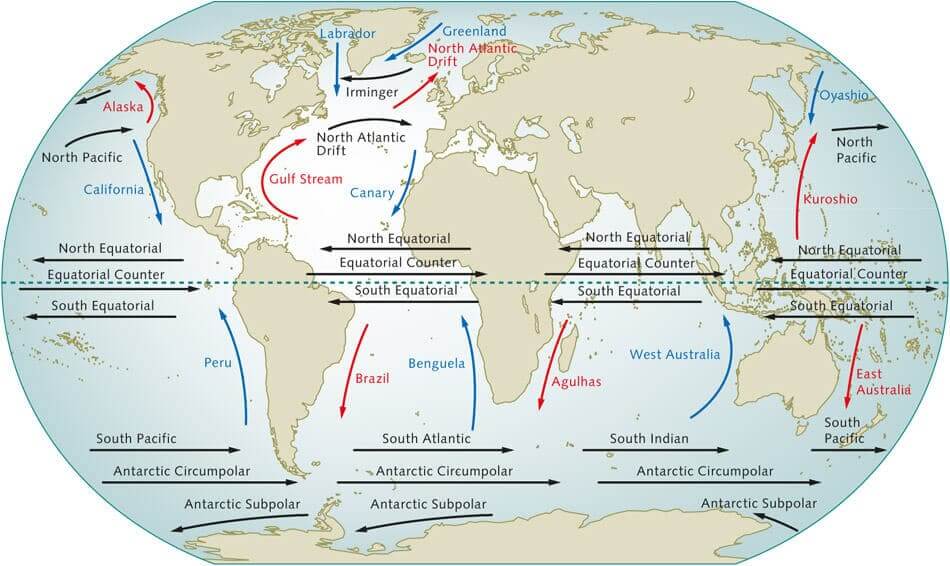
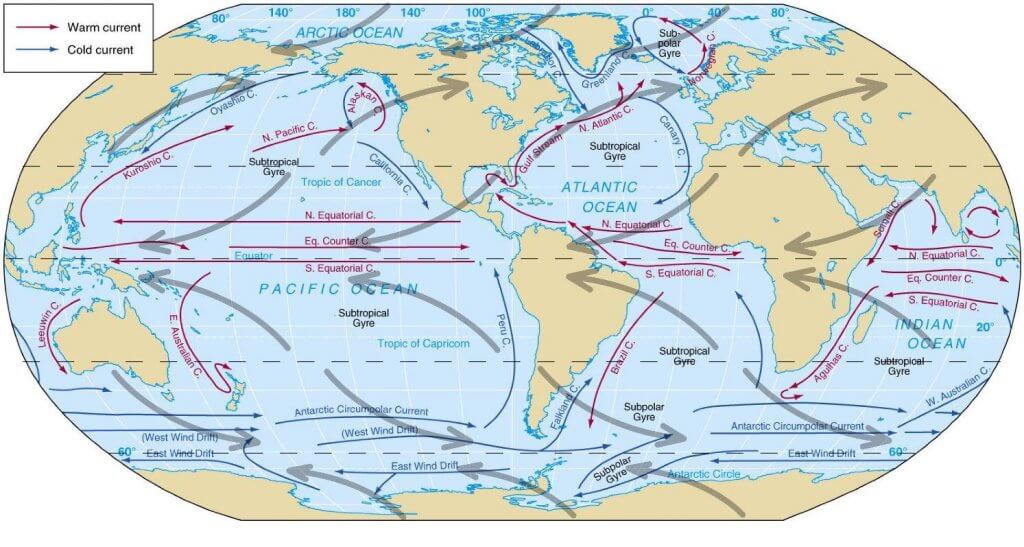
Types of Ocean Currents
Based on depth
- The ocean currents may be classified based on their depth as surface currents and deep water currents:
- surface currents constitute about 10 percent of all the water in the ocean, these waters are the upper 400 m of the ocean;
- deep water currents make up the other 90 percent of the ocean water. These waters move around the ocean basins due to variations in density and gravity.
- The density difference is a function of different temperatures and salinity
- These deep waters sink into the deep ocean basins at high latitudes where the temperatures are cold enough to cause the density to increase.
Based on temperature
- Ocean currents are classified based on temperature: as cold currents and warm currents:
- Cold currents bring cold water into warm water areas [from high latitudes to low latitudes]. These currents are usually found on the west coast of the continents (currents flow in the clockwise direction in the northern hemisphere and in anti-clockwise direction in the southern hemisphere) in the low and middle latitudes (true in both hemispheres) and on the east coast in the higher latitudes in the Northern Hemisphere;
- Warm currents bring warm water into cold water areas[low to high latitudes] and are usually observed on the east coast of continents in the low and middle latitudes (true in both hemispheres). In the northern hemisphere, they are found on the west coasts of continents in high latitudes.
Forces Responsible For Ocean Currents
Primary Forces
Influence of insolation
- Heating by solar energy causes the water to expand. That is why, near the equator the ocean water is about 8 cm higher in level than in the middle latitudes.
- This causes a very slight gradient and water tends to flow down the slope. The flow is normally from east to west.
Influence of wind (atmospheric circulation)
- Wind blowing on the surface of the ocean pushes the water to move. Friction between the wind and the water surface affects the movement of the water body in its course.
- Winds are responsible for both magnitude and direction [Coriolis force also affects direction] of the ocean currents. Example: Monsoon winds are responsible for the seasonal reversal of ocean currents in the Indian ocean.
- The oceanic circulation pattern roughly corresponds to the earth’s atmospheric circulation pattern.
- The air circulation over the oceans in the middle latitudes is mainly anticyclonic [Sub-tropical High Pressure Belt] (more pronounced in the southern hemisphere than in the northern hemisphere due to differences in the extent of landmass). The oceanic circulation pattern also corresponds with the same.
- At higher latitudes, where the wind flow is mostly cyclonic [Sub-polar Low Pressure Belt], the oceanic circulation follows this pattern.
- In regions of pronounced monsoonal flow [Northern Indian Ocean], the monsoon winds influence the current movements which change directions according to seasons.
Influence of gravity
- Gravity tends to pull the water down to pile and create gradient variation.
Influence of Coriolis force
- The Coriolis force intervenes and causes the water to move to the right in the northern hemisphere and to the left in the southern hemisphere.
- These large accumulations of water and the flow around them are called Gyres. These produce large circular currents in all the ocean basins. One such circular current is the Sargasso Sea.
Secondary Forces
- Temperature differences and salinity differences are secondary forces.
- Differences in water density affect the vertical mobility of ocean currents (vertical currents).
- Water with high salinity is denser than water with low salinity and in the same way cold water is denser than warm water.
- Denser water tends to sink, while relatively lighter water tends to rise.
- Cold-water ocean currents occur when the cold water at the poles sinks and slowly moves towards the equator.
- Warm-water currents travel out from the equator along the surface, flowing towards the poles to replace the sinking cold water.
Important ocean currents
It is important for you to remember cold and warn ocean currents.
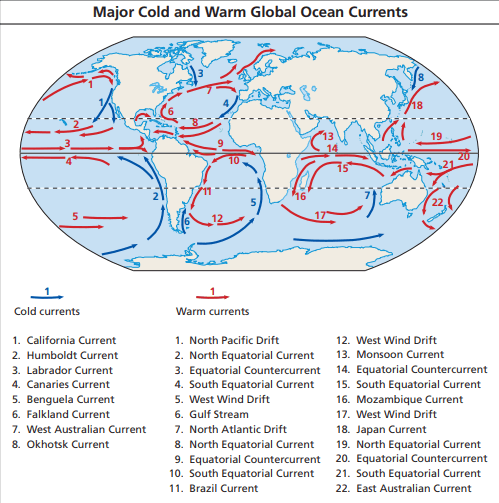
NOTE- Major Fishing grounds of the World exist where warm and cold Ocean Current meets.
Causes of Ocean Currents
Planetary Winds
- Planetary winds are one of the most important causes of ocean currents. The planetary winds blow continuously in a particular direction and drag the surface water due to the force of friction. This leads to the formation of ocean currents. Most of the ocean currents of the world follow the direction of prevailing or planetary winds.
- For example, equatorial currents flow westward under the influence of northeast and southeast trade winds. The North Atlantic Drift in the Atlantic and the North Pacific current in the Pacific move in the northeast direction under the influence of westerlies.

Variation in seawater temperatures
- There are marked variations in the horizontal and vertical distribution of the temperatures in the ocean. The temperatures are higher at the equator than at the poles. Thus, in the equatorial region, the density of water decreases due to high temperatures and more rainfalls. As a result of this, the lighter water from the equatorial region moves towards the colder and denser water of the polar areas.
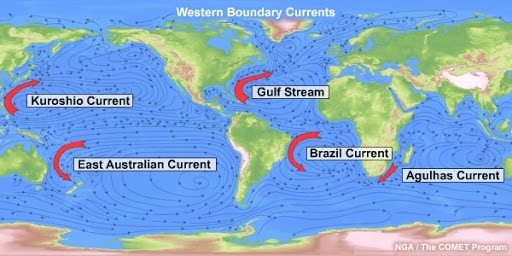
Variation in water salinity
- The amount of salts contained in seawater does vary from one part of the ocean to another. The high salinity water tends to subside and move below the water of low salinity. Ocean currents on the water surface are generated from the areas of low salinity to the areas of high salinity. There is a marked variation in the salinity of the Atlantic Ocean and the Mediterranean sea. Do you know what is salinity?
- Salinity is the saltiness of an ocean. Because of this variation, the ocean current flows from the Atlantic Ocean to the Mediterranean Sea.
Rotation of Earth
- The earth rotates on its axis from west to east. This rotation is the cause of deflective force known as Coriolis force which deflects the general direction of the winds and that of the ocean currents. For example, the currents flowing from the Equator towards the North and South Poles are deflected to their right in the Northern Hemisphere and towards their left in the Southern Hemisphere. The counter-equatorial currents are also the result of the rotation of the earth.
Configuration of the coastline
- The shape and configuration of the coastlines also have a close influence on the direction and movement of the ocean currents.
- For example, the equatorial current after being obstructed by the Brazilian coast is bifurcated into two branches. The Northern Branch is called the Caribbean current while the Southern branch is called the Brazilian current.
- In the Indian Ocean, the monsoon currents closely follow the coastlines.
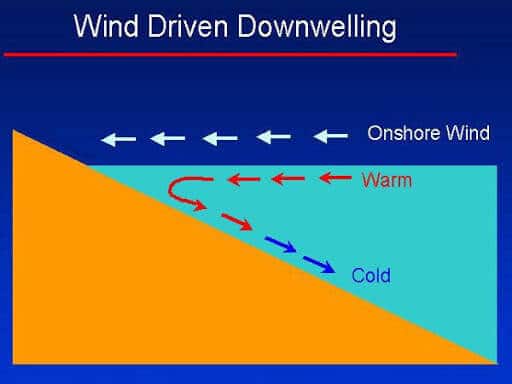
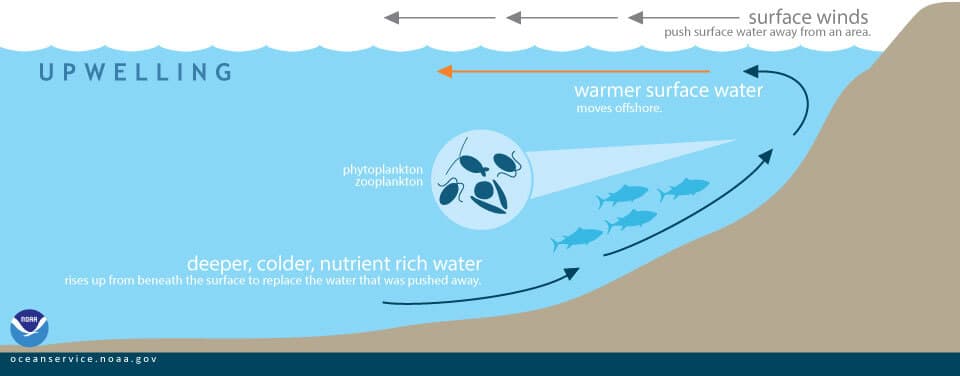
Desert Formation and Ocean Currents
Major hot deserts are located between 20-30 degree latitudes and on the western side of the continents. Why?
- The aridity of the hot deserts is mainly due to the effects of off-shore Trade Winds, hence they are also called Trade Wind Deserts.
- The major hot deserts of the world are located on the western coasts of continents between latitudes 15° and 30°N. and S (Question asked in Previous Mains Exam).
- They include the biggest Sahara Desert (3.5 million square miles). The next biggest desert is the Great Australian Desert. The other hot deserts are the Arabian Desert, Iranian Desert, Thar Desert, Kalahari, and Namib Deserts.
- The hot deserts lie along the Horse Latitudes or the Sub-Tropical High-Pressure Belts where the air is descending, a condition least favorable for precipitation of any kind to take place.
- The rain-bearing Trade Winds blow off-shore and the Westerlies that are on-shore blow outside the desert limits.
- Whatever winds reach the deserts blow from cooler to warmer regions, and their relative humidity is lowered, making condensation almost impossible.
- There is scarcely any cloud in the continuous blue sky. The relative humidity is extremely low, decreasing from 60 percent in coastal districts to less than 30 percent in the desert interiors. Under such conditions, every bit of moisture is evaporated and the deserts are thus regions of permanent drought. Precipitation is both scarce and most unreliable.
- On the western coasts, the presence of cold currents gives rise to mists and fogs by chilling the on-coming air. This air is later warmed by contact with the hot land, and little rainfalls.
- The desiccating effect of the cold Peruvian Current along the Chilean coast is so pronounced that the mean annual rainfall for the Atacama Desert is not more than 1.3 cm.
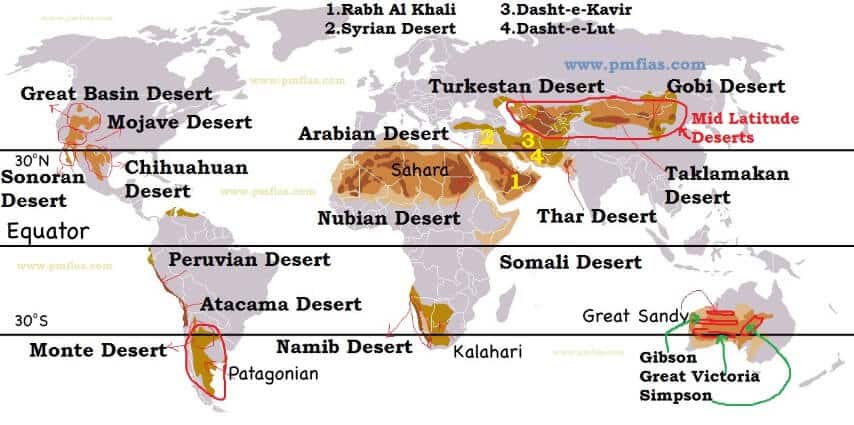
Atlantification
- Streams of warmer water from the Atlantic Ocean flow into the Arctic at the Barents Sea. This warmer, saltier Atlantic water is usually fairly deep under the more buoyant Arctic water at the surface. Lately, however, the Atlantic water has been creeping up. That heat in the Atlantic water is helping to keep ice from forming and melting existing sea ice from below. This process is called “Atlantification”.
- The ice is now getting hit both from the top by a warming atmosphere and at the bottom by a warming ocean.


Very Summarised, Kudos to the Team.
Thanks Gunjan
by accidentally find this site and now coming here again and again for best material …thanks to the team
Most of the people find this site accidentally 🙂 Keep Learning
I ALSO FOUND ACCIDENTLY AND FEELING LUCKY
Me also accidentally visited the site
Me too same
Me too the same accidental visit
i learned quite a bit after finding this page in my science class. Thanks for all the learnign
It’s very important thing
what a great content! you’ll soon beat all coaching institutes
😊
is these notes contains each and evry topics for upsc
Hello admin, I accidentally found this site and honestly it’s very useful. Please do some advertising or publicity of this content so that more students can be benefitted
Here it’s easy way to understand these ocean currents.. Briefly
By accidentally visited to this
Hi sir why you have left Economy notes? please provide it as soon as u can!
And Thanks a lot sir from the bottom of my heart for your great efforts!❣️
Sure
What the great content! You will beat all coaching institutes so soon!
god bless u sir